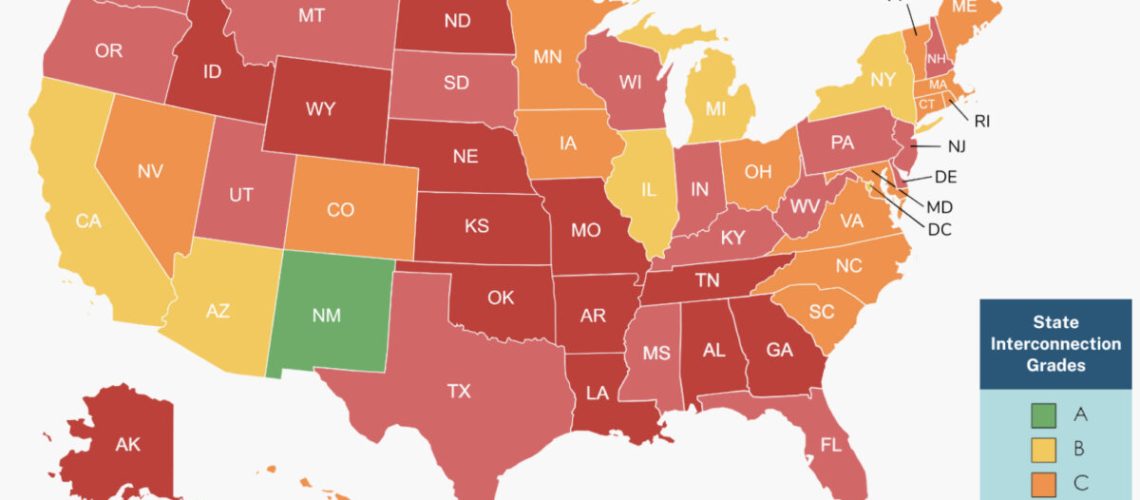IREC and Vote Solar have recommended individualized state-by-state fixes to remove barriers to interconnection of distributed solar and storage, in a set of 50 state report cards.
The Interstate Renewable Energy Council (IREC) and Vote Solar have graded each state on its policy governing interconnection of distributed solar and storage, and only one state, New Mexico, earned an A.
The two groups recommended specific ways that each individual state—even New Mexico—could improve, in report cards published in an online report, Freeing the Grid.
States have the ability to drive clean energy deployment not just through statewide goals for adoption, the report says, but also with policies that enable faster and lower-cost interconnection of distributed resources. Such policies are approved by state public utilities commissions.
“A majority of states have significant room for improvement to ensure that their interconnection policies do not present a barrier to clean energy market growth,” said IREC in a statement.
Thirty-seven states plus the District of Columbia and Puerto Rico have statewide procedures for interconnection of distributed resources. Of those, one earned a grade of A, six earned a B, 15 earned a C, and 17 earned a D. The other 13 states without statewide procedures received a grade of F.
IREC and Vote Solar graded each state using 56 interconnection criteria that “represent best practices and model provisions” drawn from IREC’s report “Model Interconnection Procedures” and IREC’s BATRIES project, which focuses on interconnection of energy storage and solar-plus-storage systems to the distribution grid.
States could also earn up to three badges in the evaluation for instituting “noteworthy best practices.”
A transparency badge was awarded to states that require pre-application reports, detailed screening and study results, itemized estimates for upgrade costs, and at least monthly public queue reporting.
An energy storage badge was earned by states that have included energy storage as an eligible technology in their interconnection rules, incorporated the concept of export capacity, and identified acceptable “export control” methods. Export control, or the ability of energy storage to control when rooftop solar exports energy to the grid, enables the grid to host more rooftop solar, IREC found—in some cases doubling a distribution circuit’s hosting capacity.
An IEEE 1547-2018 badge was given to states that have incorporated the IEEE 1547-2018 standard for smart inverters and identified or referenced performance categories as well as voltage and frequency settings for smart inverters.
The state report cards are based on 56 interconnection criteria that capture a state’s interconnection progress for distributed resources across ten categories:
- Facility types and system sizes eligible to interconnect
- Use of simplified and expedited screening procedures
- Facility and distribution system modifications
- Timelines specified for review and other processes
- Fees and other requirements for interconnection
- Incorporation of the IEEE 1547-2018 standard and export provisions
- Technical screens used as part of expedited review
- Technical screens used in supplemental review
- Provision of queue, timeline, cost, and site-specific data
- Interconnection-specific processes for resolving disputes.
The grades on the report cards focus on state procedures and do not take into account utility practices or public utility commission orders not adopted in state rules.
Looking ahead, Vote Solar expects to grade the states on compensation policies for distributed energy resources, in a report that is also expected to include findings on the racial and class equity of statewide interconnection procedures.
Between 2007 and 2017, IREC and Vote Solar released ten reports that graded the states on both interconnection and net metering policies.



